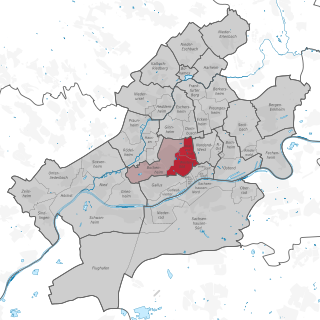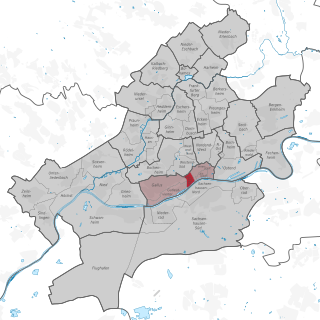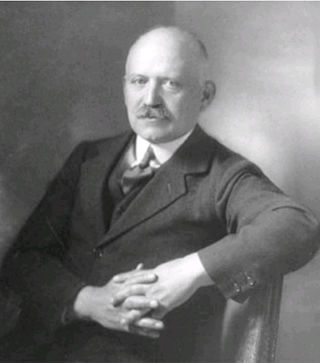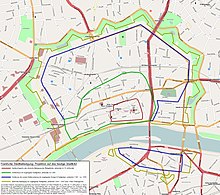
Frankfurt, officially Frankfurt am Main, is the most populous city in the German state of Hesse. Its 791,000 inhabitants as of 2022 make it the fifth-most populous city in Germany, and it is the only city in the country rated as an "alpha world city" according to GaWC. Located in the foreland of the Taunus on its namesake Main, it forms a continuous conurbation with the neighboring city of Offenbach am Main and its urban area has a population of over 2.3 million. The city is the heart of the larger Rhine-Main metropolitan region, which has a population of more than 5.8 million and is Germany's second-largest metropolitan region after the Rhine-Ruhr region and the fourth biggest metropolitan region by GDP in the European Union. Frankfurt's central business district lies about 90 km (56 mi) northwest of the geographic center of the EU at Gadheim in Lower Franconia. Like France and Franconia, the city is named after the Franks. Frankfurt is the largest city in the Rhenish Franconian dialect area.

The Altstadt is a quarter of Frankfurt am Main, Germany. It is part of the Ortsbezirk Innenstadt I and is located on the northern Main river bank. It is completely surrounded by the Innenstadt district, Frankfurt's present-day city centre. On the opposite side of the Main is the district of Sachsenhausen.

The Innenstadt is the central city district of Frankfurt am Main, Germany. It is part of the Ortsbezirk Innenstadt I. Its western part forms part of Frankfurt's central business district, the Bankenviertel. Germany's most expensive shopping streets and real estate are found within the city district.

Westend-Nord and Westend-Süd are two city districts of Frankfurt am Main, Germany. The division into a northern and a southern part is mostly for administrative purposes as the Westend is generally considered an entity. Both city districts are part of the Ortsbezirk Innenstadt II.

The Bahnhofsviertel is a quarter of Frankfurt am Main, Germany. It is part of the Ortsbezirk Innenstadt I.

The Frankfurter Kunstverein e. V. in Frankfurt am Main is a non-profit organisation dedicated to the promotion of contemporary art and culture. It is one of the oldest German art associations.

The Opernplatz is a central city square in Frankfurt, Germany, located in the district of Innenstadt and within the central business district known as the Bankenviertel. The Opernplatz is the most central square of the Bankenviertel. It is named for the Alte Oper building, which today serves as a concert hall. The Sofitel Frankfurt Opera hotel is located at Opernplatz 14. The Opera Quarter with some of Germany's most well known luxury shopping streets is located to the east of Opernplatz.

The Frankfurter Judengasse was the Jewish ghetto of Frankfurt and one of the earliest ghettos in Germany. It existed from 1462 until 1811 and was home to Germany's largest Jewish community in early modern times.
The Frankfurt Marathon is a marathon which has taken place every year in Frankfurt am Main since its inception in 1981. It is the longest-established city marathon in Germany and in terms of the number of finishers, Germany's second-largest. It is organised by the agency motion events.

The Frankfurt am Main tramway network is a network of tramways forming a major part of the public transport system in Frankfurt am Main, a city in the federal state of Hesse, Germany.
Eschenheimer Turm was a city gate, part of the late-medieval fortifications of Frankfurt am Main, and is a landmark of the city. The tower, which was erected at the beginning of the fifteenth century, is at once the oldest and most unaltered building in the largely reconstructed Frankfurter Neustadt, now better known as the Innenstadt.

Frankfurt am Main Konstablerwache station is a major train station and metro station at the Konstablerwache square in the city centre of Frankfurt am Main, Germany.

Frankfurt (Main) Taunusanlage station is a train station in the city centre of Frankfurt, Germany. It is served by eight S-Bahn lines.

The Line C is a line on the Frankfurt U-Bahn. It consists of the U6 and the U7.

The Dominican Monastery is a former Christian monastery in Frankfurt am Main. It is the seat of Protestant Regional Association, a group of Protestant congregations and deaneries in the city, and serves as the convention site for the Synod of the Protestant Church in Hesse and Nassau, held usually twice a year. The former monastery compound includes a Lutheran church building, called the Church of the Holy Spirit.

The Hochstraße is a short street in the city centre of Frankfurt, Germany, located in the Opera Quarter in the western part of the district of Innenstadt, within the central business district known unofficially as the Bankenviertel.

The Bockenheimer Depot is a former tram depot and main workshop of the Straßenbahn Frankfurt am Main, built around 1900. It is located in the Bockenheim quarter of Frankfurt. A listed monument, it now serves as a theatre venue of the Städtische Bühnen Frankfurt, mostly for Baroque and contemporary opera.

The fortifications of Frankfurt were a system of military defences of the German city of Frankfurt am Main which existed from the Middle Ages into the 19th century. Around 1000 the first city wall was built. It enclosed the area of what is now the Königspfalz in modern Frankfurt. In the twelfth century the settlement expanded into what is now Altstadt. For its protection an additional wall, the Staufenmauer, was erected. Starting in 1333, the Neustadt suburb developed north of the Altstadt and was encompassed by an additional wall with five gates. In the fifteenth century, a "landwehr border" was created around the entire territory of the Free City of Frankfurt. Beginning in 1628, the medieval city wall was developed to form a bastion fortress under the municipal architect Johann Dilich.

Carl von Weinberg was an important Jewish German chemist, entrepreneur, patron of the arts and philanthropist.

Nizza is a small area in central Frankfurt-am-Main, Germany, known for its microclimate that makes it one of the warmest places in Germany. Nizza is on the northern bank of the River Main, and the combination of its open southern-facing position, the urban heat island, the high walls of the adjacent promenade which act as a windbreak, and reflection of sunlight off the water combine to produce a Mediterranean climate. At 4.42 hectares, Nizza is one of the largest gardens of Mediterranean plants north of the Alps.





















